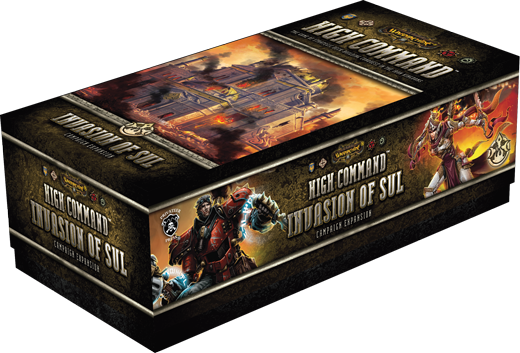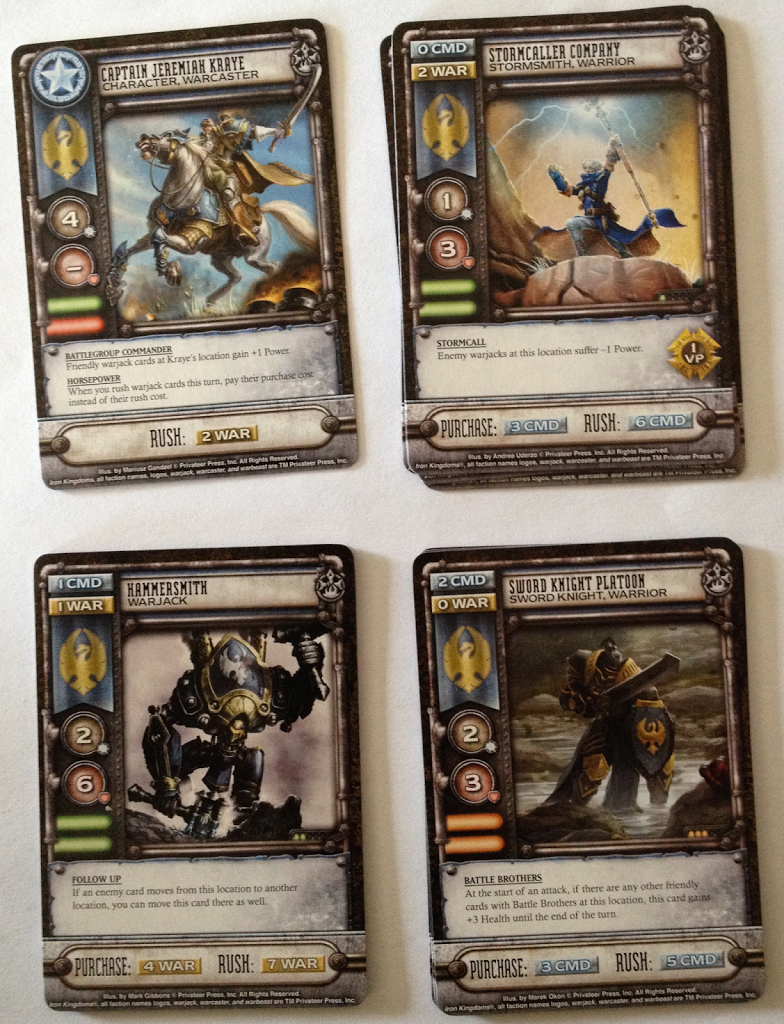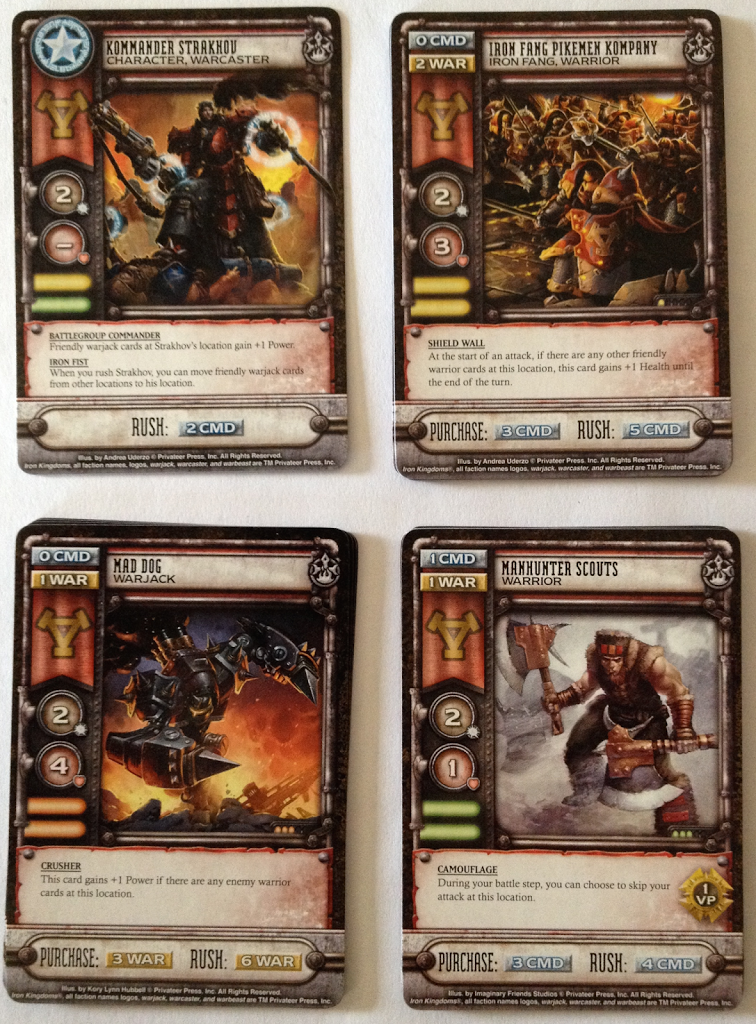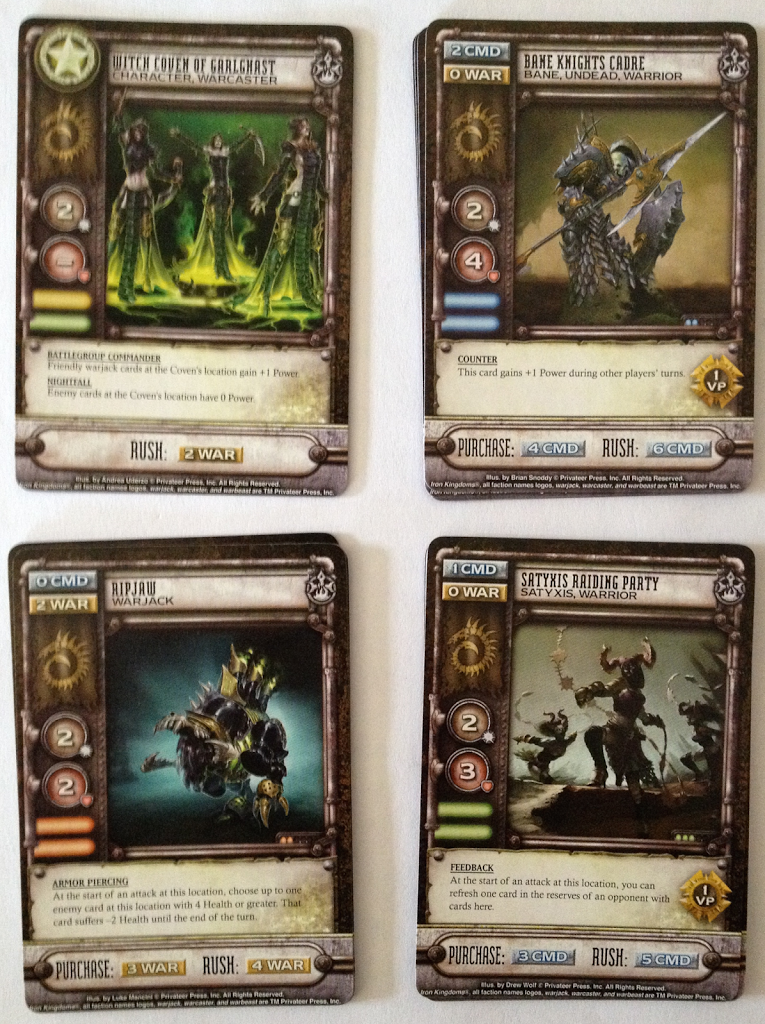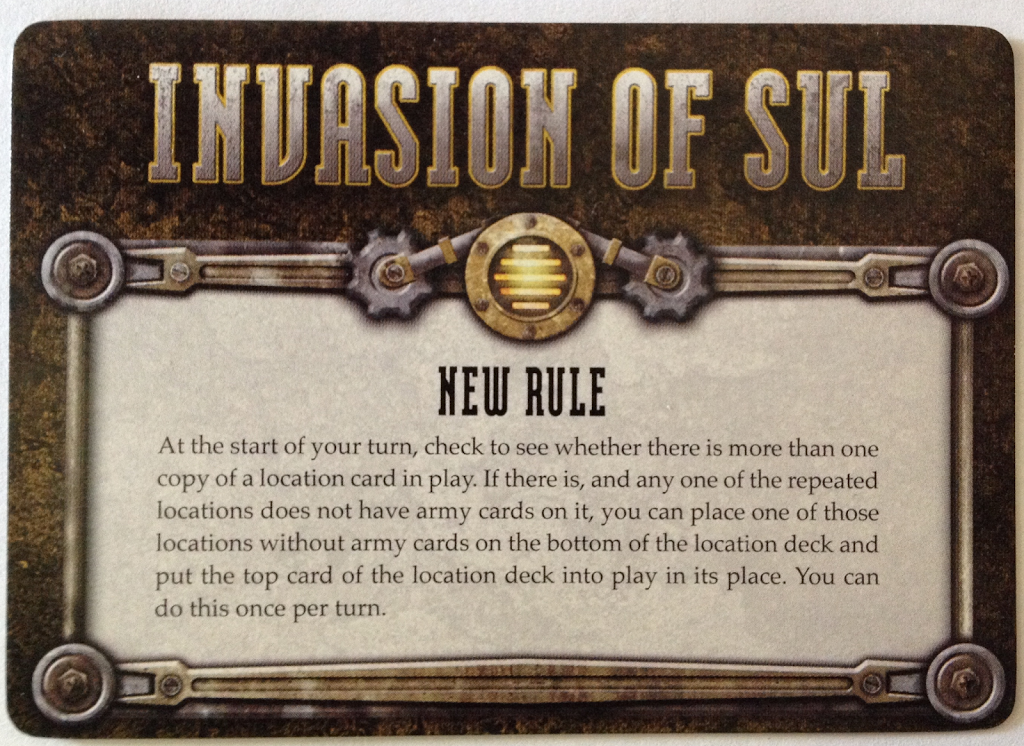Warmachine: High Command – Invasion of Sul Review

Warmachine: High Command has already seen three smaller expansions with The Big Guns, Into the Breach, and Heroes & Legends. Each of these expansions introduced a new warcaster for every faction in addition to four new detachment cards. Each of these new expansions has helped High Command develop an ever-expanding external metagame that goes beyond simple warcaster and detachment choice. The Invasion of Sul campaign expansion is not entirely unlike these earlier expansions in that it has a new warcaster and three new detachment cards (in lieu of the normal group of four). Unlike these earlier expansions, it brings along a new series of Winds of War and Location cards as well.
Let’s start by diving into the individual factions:
Cygnar –
The new warcasters in Invasion of Sul won’t necessarily be new to all, as they are general release cards of the prizes from the original Warmachine: High Command release events from last year. The only thing that changes at all on these cards is the icon in the upper right-hand corner indicating that they are a part of the Invasion of Sul set. Cygnar’s “new” warcaster in the set is Captain Jeremiah Kraye. Kraye boasts fair hitting strength at 4 Power and his special ability, Horsepower, makes him a fantastic choice for reinforcing your hold on different locations. It specifically states “When you rush warjack cards this turn, pay their purchase cost instead of their rush cost”. It’s important to note that it doesn’t specify that warjacks are being rushed specifically to his location, so you may send them to any location you wish, not simply the one he occupies.
Cygnar’s three detachment-based additions are the Hammersmith, Stormcaller Company, and Sword Knight Platoon. The Hammersmith comes in at 2 Power and 6 Health with the Follow Up ability, allowing the Hammersmith to follow a card that moves from its location to another. While this ability might sound less-than thrilling, the nature of many of the location cards in Invasion of Sul will place increased importance on mobility and being able to redeploy forces. At 4 WAR to-purchase and 7 WAR to-rush, the Hammersmith is a solid investment for its cost, particularly in multiplayer games or with this set’s location cards, albeit at the expense of not scoring any VPs.
The Stormcaller Company is more of a defensive piece at 1 Power, 3 Health, and with the Stormcall ability, reducing the Power of enemy warjacks at their location by 1. As it is worth 1 VP, can generate 2 WAR for purchasing, and has a reasonable purchase cost, Stormcaller Companies are decent investments for builds that seek to use warjacks or pursue VP purchasing strategies.
Lastly for Cygnar, the Sword Knight Platoon is another defensive piece for orange and red detachments. At 2/3, it doesn’t have the most exciting stat line, but with the Brothers in Arms ability, having multiple Sword Knight Platoons at one location will increase their Health to an impressive 6, which is incredibly solid for a 3 CMD to-purchase, 5 CMD to-rush unit. Since their value is really predicated upon being able to trigger their Health buff, it would be a good idea to include as many Sword Knight Platoons as you can if you are planning on taking any at all.
Protectorate of Menoth –
The Protectorate’s new warcaster in Invasion of Sul is Thrya, Flame of Sorrow. Like Kraye, she comes in at 4 Power and rushes for 2 WAR. Her special ability, Shadows of Urcaen allows to you move one friendly card from another location to her location. While this may not sound terribly impressive, it is an ability that comes in handy in the Invasion of Sul set when playing with its location cards, particularly with the Narrow Streets locations, which warjacks, warcasters, and warrior cards cannot be rushed to. Instead, you can rush a card to another location, rush Thyra to the Narrow Streets, then move the first card to join her.
The Invasion of Sul set introduces three new detachment cards for Menoth players: the Sanctifier, Knights Exemplar Seneschal, and Temple Flameguard Champions. The Sanctifier is a really interesting warjack choice for the Protectorate. At 1/5, it doesn’t have the most impressive of stat blocks, but it is worth noting that it is only 4 to-purchase and has a value of 1 VP. What really makes the Sanctifier appealing is the Cenotaph ability, which grants it +1 Power for every three cards in the your occupying forces pile (rounded down). Since the Protectorate is typically stronger at grabbing locations than pursing VP purchasing strategies, and they already have other cards that allow you to move cards to occupying forces without capturing, this plays towards the Protectorate’s strengths fairly nicely and makes the Sanctifier a great snowballing card, also interacting really well with the new location card from this set, Menite Temple, which allows you to move your cards that were destroyed at a Menite Temple to the occupying forces pile instead of the discard pile.
The Knights Exemplar Seneschal is great addition to Exemplar-heavy builds. It is 3 CMD to-purchase and 6 to-rush with 2 Power and 3 Health. Its special ability, Righteous Fury, grants it +1 Power and Health if there are any Exemplar cards in your discard pile, which is not a hard ability to proc given that both Exemplars and Errants have some CMD purchasing power, but using them in this way may not be the best course of action given specific circumstances that might better warrant the presence of the other cards.
The Temple Flameguard Champions are effectively the Temple Flameguard Phalanx on steroids. With higher Power and Health, bringing 1 VP, having excellent purchasing power at 2 CMD/2 WAR, and the Iron Zeal rule, which changes their Health stat to base 5 the turn they are deployed or rushed, Flameguard Champions are just-plain great in any deck.
Khador –
Khador’s newest warcaster in Invasion of Sul is Kommander Strakhov. While his 2 Power isn’t the most thrilling of offensive stats, his special ability, Iron Fist, allows him to move friendly warjack cards from other locations to his locations, making it effectively an unlimited warjack-specific version of Thyra’s Shadows of Urcaen.
Khador’s three new detachment cards are the Mad Dog, Ironfang Pikeman Kompany, and Manhunter Scouts. The Mad Dog is the first card in Warmachine: High Command that is actually brand new to either Warmachine or High Command. It appears to use the Berserker chassis but forgoes the paired axes for enormous punching spikes. At 2 Power and 4 Health at 3 WAR to-purchase and 6 WAR to-rush, it isn’t a bad, little package for its cost, particularly given the Crusher ability, granting +1 Power if there are enemy warrior cards present at its location. While it doesn’t score any VPs, its potential damage output for its cost makes it an interesting early-game card for Khador players that wish to shift their game plan more towards a capturing-style strategy.
The Ironfang Pikemen Kompany is more of a cheap, defensive piece for Khador players looking for a little more warjack purchasing power. While its 2 Power and 3 Health is not terribly impressive for its 3 CMD to-purchase/5 to-rush cost, the Shield Wall ability gives it a little staying power if there are other friendly warrior cards present at their location. Additionally, the Ironfangs value in at 2 WAR for purchasing, making them a solid addition to warjack-heavy builds.
Khador’s final new addition in Invasion of Sul is the Manhunter Scouts card. At 3 CMD to-purchase, 4 to-rush and being worth a VP, this cards plays strongly into Khador’s typical VP-purchasing strategy. Stat-wise, it comes in at 2 Power and 1 Health, making it terribly fragile for its cost without a ton of hitting power. However, the Camouflage ability makes it an extremely interesting card, particularly for the defensive turtling play style that Khador favors. Camouflage states that during your battle step, you can choose to skip your attack at this location. This effectively allows the Khador player to deploy the Scouts to a location camped by two-or-more enemy forces, skip the battle step so that the Scouts survive, and potentially deny the opponent from scoring the location on the following turn. The nature of the Camouflage ability makes it better for duel games than for multiplayer, however, so keep this in mind when building your detachments.
Cryx –
The final new warcaster addition is the Witch Coven of Garlghast. While their 2 Power isn’t going to change lives, their special ability, Nightfall is incredibly potent under nearly any circumstance. Nightfall states that enemy cards at the Coven’s location have 0 Power, playing extremely well into Cryx’s glass cannon, swarm-style of play.
Cryx’s new detachment cards in Invasion of Sul are the Ripjaw, Bane Knight Cadre, and Satyxis Raiding Party. The Ripjaw is a budget warjack with 2 Power, 2 Health, and the Armor Piercing ability, which reduces the health of an enemy card with 4 Health or greater by two until the end of the turn. It’s a great, little piece for taking down hardened targets and additionally has 2 WAR in purchasing power with a low rush cost of 4, making it a fairly versatile card to have in-hand.
The Bane Knight Cadre bring 2 Power and 4 Health to fight in addition to the Counter rule, granting it +1 Power during other players’ turns. At 4 CMD to-purchase, 6 to-rush and carrying 1 VP and 2 CMD for purchasing, it is a strong addition to blue purple and red detachments.
The Satyxis Raiding Party is another card with a unique and interesting ability: Feedback. This ability states that at the start of an attack at their location, you can refresh one card in the reserves of an opponent with cards also at their location. This can make the Raiding Party a nice denial tool for those moments when your opponent flips a card that might tip the balance in their favor. In addition to Feedback, the Raiding Party purchase for 3 CMD, rushes for 5, is worth a single VP, and has stat block of 2/3.
Locations –
As mentioned earlier, the Invasion of Sul expansion introduces new location and Winds of War cards to the game to create new play experiences for veteran players. The first thing a veteran will notice is that, unlike the core set, there are many duplicate locations in this expansion. With these duplicate cards comes a new rule, allowing players to refresh unoccupied duplicate locations at the beginning of their turn. While this might not sound terribly important, fighting an entire game on Narrow Streets and being denied the ability rush would not an exciting game make.
The first new location, Gates of Sul has three copies, is worth 2 CMD, 2 WAR, and an impressive 8 VP, and has a rule stating that during the battle step, if one of your cards is destroyed at this location, your other cards here cannot be destroyed this turn. This will inevitably make capturing this card extremely difficult and will lend itself well to strategies built around redeploying cards as well as taking advantage of cards with the Superior Range, Stealth, or Shield Guard rules.
Walls of Sul also comes with three copies, is worth 3 CMD, 3 WAR, and 7 VP, and states that cards at this location with less than 4 base Health have 4 base Health, making it a great location to send swarms of low-Health infantry. This also makes Walls of Sul rather difficult to assault, again playing well into mobility-based strategies.
Narrow Streets has three copies, is worth 2 CMD, 3 WAR, and 6 VP, but denies warbeasts, warjacks, and warrior cards from being rushed to them. As mentioned earlier, there are a few warcaster-based tricks that might allow you to get around this limitation, specifically Strakhov’s and Thyra’s special abilities.
Menite Temple is the final three-copy card, is worth 3 CMD, 2 WAR, 5 VP, and has a rule stating that if one of your cards is destroyed at this location, you can move it to your occupying forces pile. As mentioned earlier, this can work incredibly well with the Sanctifier warjack and its Cenotaph rule, but can also be used to cull your deck of weaker early-game cards that might not be as advantageous in the mid-to-late game.
The Exemplar Acropolis comes in a single copy, is worth 2 CMD, 2 WAR, 8 VP, and grants warriors cards present +2 Power and +2 Health, giving a superior advantage to warrior cards, particularly with those decks relying on swarm tactics like the Protectorate or Cryx often do.
The Temple of the Creator is a single-copy card, is worth 4 CMD, 4 WAR, and worth 10 VP, making it of extremely high value to anyone who can capture it. Its special ability, however, states that if one of your cards is destroyed at this location, move it to your occupying forces pile. Unlike the Menite Temple card, moving destroyed cards to occupying forces is not optional, making attempts to take the Menite Temple extremely risky.
Finally, Sulon’s Fortress is another single-copy card worth 3 CMD, 3 WAR, and worth only 4 VP. However, it is extremely easy to capture due to its special rule that states if you control three warrior cards at this location, immediately capture this location.
Winds of War –
The first new Early phase Winds of War card is Invasion Plans, which is a more aggressive form of the Requisition card from the core set. It states that the cost of the first card you purchase or deploy this round is decrease by 2 CMD or 2 WAR. This card is especially nice in this set since many of the locations are especially hard to capture due to their special rules.
Vanguard, which comes in both Early and Mid variants, states that you can deploy cards with a cost of 2 CMD or 2 WAR without paying their purchase cost this round. While this card is effectively useless during the first two turns of the game, it can certainly be handy later on, and may even be powerful enough to dictate detachment builds and early purchasing just enough to help make playing with this campaign expansion even more unique.
Plan of Attack, the final Early card, states that when you add a card to your reserves, look at the top two cards of your reinforcement deck. Put one in your reserves and the other on the bottom of your reinforcement deck. This certainly helps a lot with early-game card draw issues, which are all-too-common in card games.
Ongoing Reinforcement is a Mid-game card stating that each time one of your cards is destroyed or discarded from a location this round, draw one card. I like this card quite a bit, particularly in the context of this expansion, as it tends to award aggressive style of play in an environment that might otherwise result in long, drawn-out turtlefests.
Tactical Retreat comes in both Mid- and Late-game forms and states that at the start of your turn this round, you can return a friendly card from a location to your hand, if you do, draw two cards. This can not only be an effective tactic to improve your card advantage, but can also be a way to cycle through location cards if the card your return happened to be the only card at a specific location, helping to make the game more dynamic and ever-changing.
Coordinated Assault also has Mid- and Late-game forms and states that if you deploy or rush a warjack or warbeast during your turn this round, the rush cost of your warcaster and warlocks is decreased by 2 CMD or 2 WAR that turn. I like this ability a lot for several reasons. First, I have played loads of games, particularly with new players, where they completely neglect to rush their warcasters during the game. Coordinated Assault can act as a catalyst for many new players to get them to take advantage of cards that might otherwise never come into play. Second, this makes the expensive 5 CMD/5 WAR to-rush warcasters from the Heroes and Legends that much more attractive.
Last Stand is a Late-game game card and is fairly simple given the rest of the location cards in the expansion. It states that warbeast, warjack, and warrior cards gain +2 Health this round. I am not sure about how terribly thrilled I am about this card given how difficult removal is with the Walls/Gates of Sul locations, but it certainly will get players to fully-commit to single locations if they want to capture anything in the games closing moments.
The final Late-game card is Day of Reckoning and is direct copy of the card from the core rules, ending the game immediately and allowing players to capture locations if they have at least two-or-more cards than any other player there.
Closing Thoughts –
Overall, I’m really pleased with the Invasion of Sul expansion. While the packaging for the expansion may have lead to the most anti-climatic unboxing ever, it makes for an attractive means to carry a pair of decks and a set of location and Winds of War cards so that you needn’t carry around the massive box from the core set. The new cards all introduce new ways to approach detachment building as well as exciting new mechanics through the new campaign cards.
This is a great new way to play for people who have picked up every expansion or people who just own the core set. Grab it fast!

